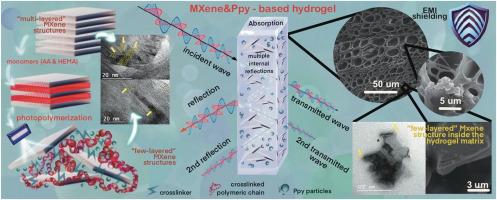含Mo-MXenes的光聚合低膨胀水凝胶,用于电磁干扰屏蔽应用
IF 6.8
3区 材料科学
Q1 MATERIALS SCIENCE, MULTIDISCIPLINARY
Journal of Science: Advanced Materials and Devices
Pub Date : 2025-06-25
DOI:10.1016/j.jsamd.2025.100938
引用次数: 0
摘要
紧凑、耐用和高度集成的电子产品的进步决定了对有效屏蔽电磁干扰(EMI)的需求。本研究的重点是通过直接的光聚合策略获得用于电磁干扰屏蔽应用的水凝胶的合成和表征。将不同浓度的Mo2Ti2AlC3(0.1%, 0.2%和0.4 wt %)和聚吡啶颗粒(作为导电成分)掺入具有半互穿聚合物网络(sIPN)的水凝胶中,该网络是由甲基丙烯酸羟乙酯(HEMA)和丙烯酸(AA)在聚乙烯醇(PVA)存在下光聚合而成的。在聚乙烯醇中对Mo2TiAlC3进行超声预处理,改善了嵌入层,保证了水凝胶膜的均匀整合。表征技术,包括SEM, TEM, FT-IR,力学测试,TGA, XRD和EMI屏蔽测量,为mxenes基水凝胶的性质和性能提供了有价值的见解。这些水凝胶表现出高凝胶分数值(> 98%)和减少肿胀,表明交联密度增加。MXenes在水凝胶基质中的最佳色散(0.1-0.2 wt %)增强了机械性能和有效的电磁干扰屏蔽,其中hgel - mx - 0.1%样品显示出最佳的电磁干扰屏蔽效率。水凝胶中水的存在确保了整个复合水凝胶基质的均匀导电性。这种创新的方法突出了mxenes水凝胶等柔性材料在先进技术应用中的潜力,具有卓越的粘弹性、机械稳定性和有效的电磁干扰屏蔽。本文章由计算机程序翻译,如有差异,请以英文原文为准。

Photopolymerized low-swelling hydrogels incorporating Mo-MXenes for EMI shielding applications
The advancement of compact, durable, and highly integrated electronics dictates the need for effective shielding from electromagnetic interference (EMI). This study was focused on the synthesis and characterization of hydrogels designed for EMI shielding applications obtained by a straightforward photopolymerization-based strategy. Different concentrations of Mo2Ti2AlC3 (0.1 %, 0.2 %, and 0.4 wt %), and polypyrrole particles, which serve as electroconductive components, were incorporated into hydrogels with a semi-interpenetrated polymer network (sIPN) resulting from the photopolymerization of hydroxyethyl methacrylate (HEMA) and acrylic acid (AA) in the presence of polyvinyl alcohol (PVA). Ultrasonication pretreatment of Mo2TiAlC3 in polyvinyl alcohol improved intercalation and ensured uniform integration into hydrogel films. Characterization techniques, including SEM, TEM, FT-IR, mechanical tests, TGA, XRD, and EMI shielding measurements, provided valuable insights into the properties and performance of the MXenes-based hydrogels. These hydrogels exhibited high gel fraction values (>98 %) and reduced swelling, indicating an increased crosslinking density. The optimal dispersion of MXenes (0.1–0.2 wt %) in the hydrogel matrix resulted in enhanced mechanical performance and effective EMI shielding, with the Hgel-MX-0.1 % sample displaying the best EMI shielding efficiency. The presence of water in the hydrogels ensures uniform conductivity throughout the composite hydrogel matrix. This innovative approach highlights the potential of flexible materials like MXenes-based hydrogels for advanced technological applications, offering superior viscoelastic properties, mechanical stability, and effective EMI shielding.
求助全文
通过发布文献求助,成功后即可免费获取论文全文。
去求助
来源期刊

Journal of Science: Advanced Materials and Devices
Materials Science-Electronic, Optical and Magnetic Materials
CiteScore
11.90
自引率
2.50%
发文量
88
审稿时长
47 days
期刊介绍:
In 1985, the Journal of Science was founded as a platform for publishing national and international research papers across various disciplines, including natural sciences, technology, social sciences, and humanities. Over the years, the journal has experienced remarkable growth in terms of quality, size, and scope. Today, it encompasses a diverse range of publications dedicated to academic research.
Considering the rapid expansion of materials science, we are pleased to introduce the Journal of Science: Advanced Materials and Devices. This new addition to our journal series offers researchers an exciting opportunity to publish their work on all aspects of materials science and technology within the esteemed Journal of Science.
With this development, we aim to revolutionize the way research in materials science is expressed and organized, further strengthening our commitment to promoting outstanding research across various scientific and technological fields.
 求助内容:
求助内容: 应助结果提醒方式:
应助结果提醒方式:


